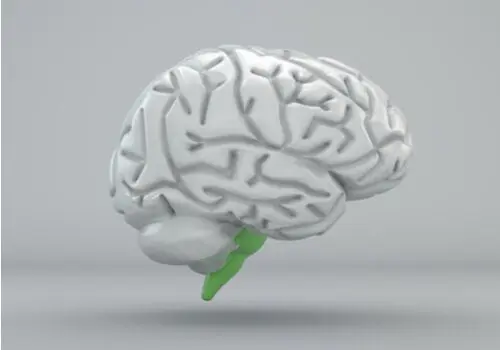Contents
Spinal bulb
The medulla oblongata, also called the elongated medulla, is a part of the brainstem, belonging to the central nervous system and playing an essential role in survival functions.
Anatomy of the medulla oblongata
Position. The medulla oblongata forms the lower part of the brainstem. The latter originates under the brain within the cranial box and passes through the occipital foramen to join the upper part of the vertebral canal, where it will be extended by the spinal cord (1). The brainstem is made up of three parts: the midbrain, the bridge and the medulla oblongata. The latter is thus located between the bridge and the spinal cord.
Internal structure. The brainstem, including the medulla oblongata, is made up of a gray substance surrounded by a white substance. Within this white matter, there are also gray matter nuclei from which 10 of the 12 cranial nerves emerge (2). Among the latter, the trigeminal nerves, abducent nerves, facial nerves, vestibulocochlear nerves, glossopharyngeal nerves, vagus nerves, accessory nerves and hypoglossal nerves emerge totally or partially from the medulla oblongata. Other motor and sensory nerve fibers are also found in the structure of the medulla oblongata in the form of protrusions such as pyramids or olives (2).
External structure. The posterior surface of the medulla oblongata and the bridge form the front wall of the fourth ventricle, a cavity in which cerebrospinal fluid circulates.
Physiology / Histology
Passage of motor and sensory pathways. The medulla oblongata constitutes a passage area for many motor and sensory pathways.
Cardiovascular center. The medulla oblongata plays an essential role in cardiac regulation. It modulates the frequency and strength of the heart’s contractions. It also modulates blood pressure by impacting the diameter of blood vessels (2).
Respiratory center. The medulla oblongata initiates and modulates respiratory rhythm and amplitude (2).
Other functions of the medulla oblongata. Other roles are associated with the medulla oblongata such as swallowing, salivation, hiccups, vomiting, coughing or sneezing (2).
Pathologies of the medulla oblongata
Bulbar syndrome refers to the various pathologies affecting the medulla oblongata. They can be of degenerative, vascular or tumor origin.
Stroke. Cerebrovascular accident, or stroke, is manifested by obstruction, such as the formation of blood clots or the rupture of a cerebral blood vessel.3 This condition can affect the functions of the medulla oblongata.
Head trauma. It corresponds to a shock to the skull which can cause brain damage. (4)
Parkinson disease. It corresponds to a neurodegenerative disease, the symptoms of which are in particular a tremor at rest, or a slowing down and reduction in the range of motion. (5)
Multiple sclerosis. This pathology is an autoimmune disease of the central nervous system. The immune system attacks the myelin, the sheath surrounding nerve fibers, causing inflammatory reactions. (6)
Tumors of the medulla oblongata. Benign or malignant tumors can develop in the medulla oblongata. (7)
Treatments
Thrombolyse. Used in stroke, this treatment consists of breaking up the thrombi, or blood clots, with the help of drugs.
Drug treatments. Depending on the pathology diagnosed, different treatments may be prescribed such as anti-inflammatory drugs.
Surgical treatment. Depending on the type of pathology diagnosed, surgical intervention may be carried out.
Chemotherapy, radiotherapy. Depending on the stage of the tumor, these treatments may be prescribed.
Examination of the medulla oblongata
Physical examination. First, a clinical examination is performed in order to observe and assess the symptoms perceived by the patient.
Medical imaging exam. In order to assess brainstem damage, a cerebral and spinal CT scan or a cerebral MRI can in particular be performed.
biopsy. This examination consists of a sample of cells.
Lumbar puncture. This exam allows the cerebrospinal fluid to be analyzed.
History
Thomas Willis is an English doctor considered one of the pioneers of neurology. He was one of the first to present a concrete description of the brain, notably through his treatise cerebral anatome. (8)










